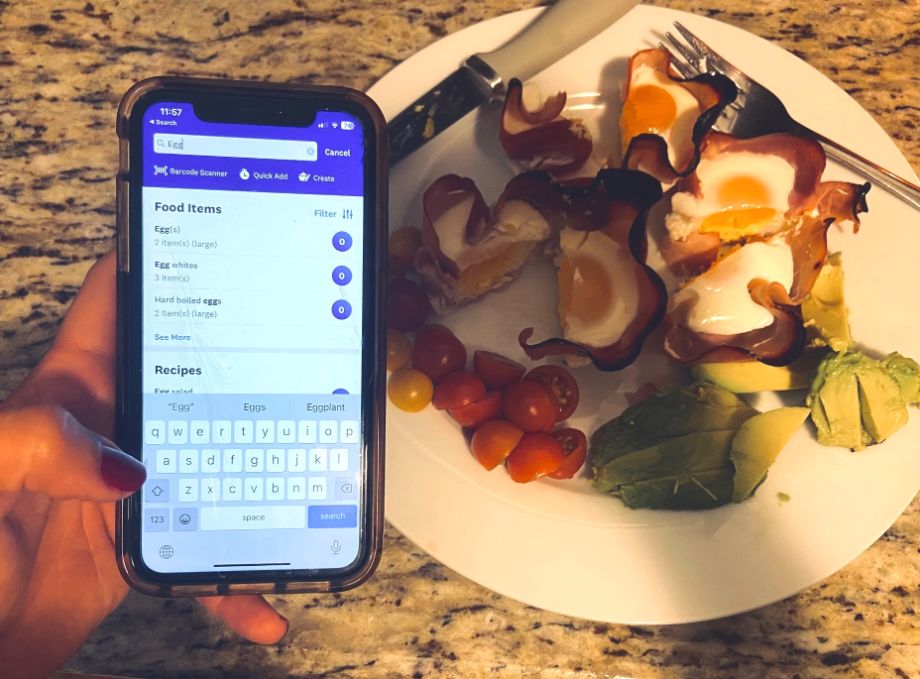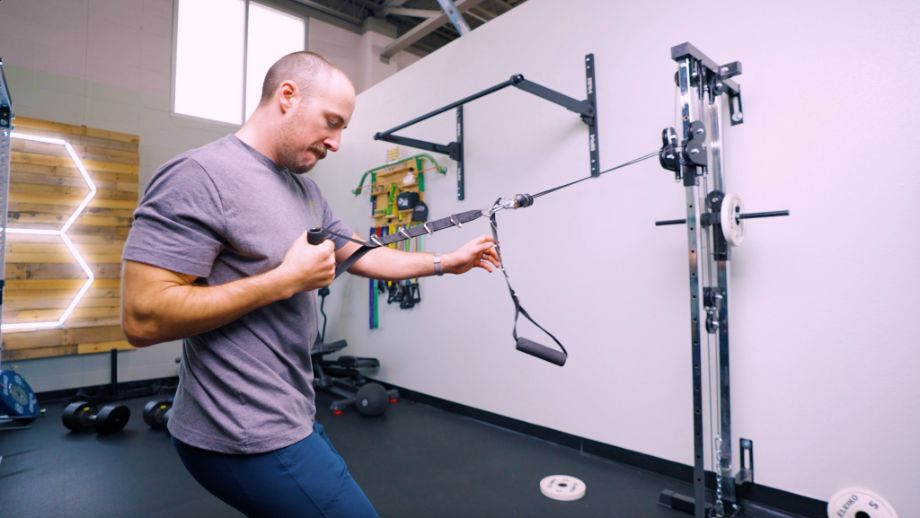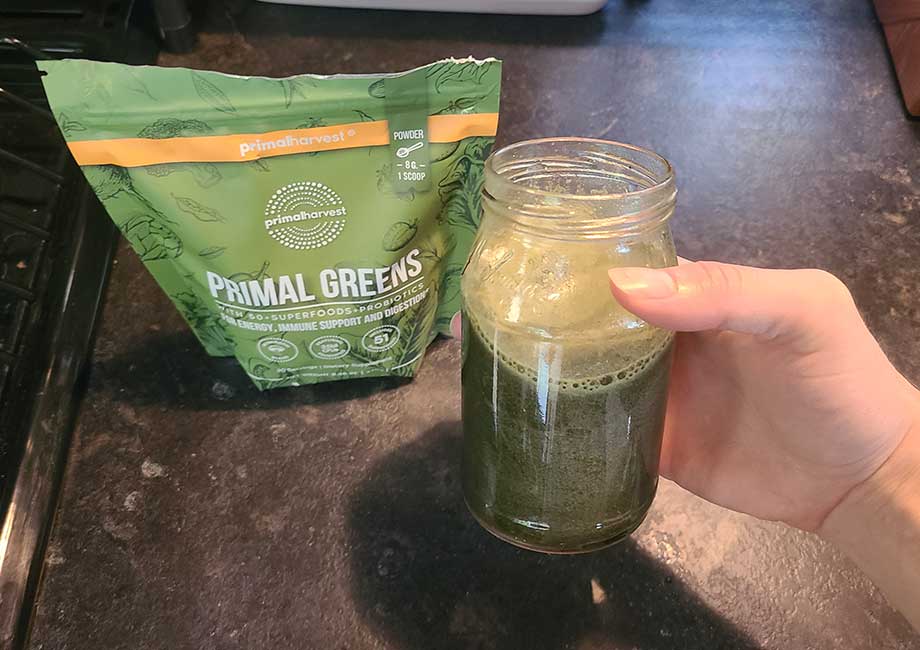Noom and Weight Watchers (WW) are two of the most popular weight loss programs. And while they share some commonalities, they’re a lot different. You’ll likely see success with either program—if consistent—but choosing the right one for you comes down to what you hope to get out of it.
Noom emphasizes learning and psychology-based techniques, while Weight Watchers is more of a simplified food-tracking program. In this Noom vs Weight Watchers guide, we’ll compare both programs to help you decide whether to try one.
Editor’s Note and Medical Disclaimer: This article is intended for educational and informational purposes only. It is not intended as a substitute for medical advice. Weight loss programs are not recommended for people with a history of disordered eating. For health advice, contact a licensed healthcare provider. If you need help with disordered eating, contact NEDA.
Comparison Chart
Before we get into the nitty-gritty details, here’s a quick glance at pricing, subscription options, diets supported, and other information that can help you decide which program is a better fit:
| Noom | Weight Watchers | |
| Pricing | $17-$70 per month, based on commitment | $10-$23 per month, based on commitment (some plans also require a $20 “starter fee”) |
| Trial | 7 or 14-day free trial, depending on current promo | 30-day free trial (digital Core membership) |
| Subscription options | Monthly, 2-month, 3-month, 4-month, 5-month, 6-month, 7-month, 8-month, 9-month, 10-month, 11-month, yearly | Monthly, 3 months, 10 months |
| Access to professionals | Yes | Yes |
| Diets supported | All | All |
| Platforms | App only | App, desktop, in-person |
Quick Look: Noom vs Weight Watchers
What Is Noom?
Noom App
Noom

Product Highlights
- Uses a psychology-backed approach to weight loss
- Provides behavioral guidance more than nutritional guidance
- App supports food, weight, and activity tracking
- Multiple membership options available
- A stress-relief plan is also available
Pros & Cons
Pros
- Gives you freedom to make your own choices
- Helps you identify patterns and behaviors that may be connected to your weight
- Flexible payment options
- 1:1 coaching plans are available for purchase
Cons
- Doesn’t offer much nutritional guidance
- May not be the best option for those who need a more structured plan
- Expensive on the month-to-month plan
Bottom Line
Noom is built on the psychology of weight loss. Instead of specific nutritional guidance, you’ll get lessons that are designed to help you break habits that may be contributing to your weight gain.
Noom is a psychology-based weight loss program that uses cognitive behavioral therapy (CBT) techniques to enforce long-term lifestyle changes. The company takes the stance that weight gain and obesity are tied to unhealthy ingrained behaviors and that the key to long-term weight loss (or healthy weight maintenance) is changing these behaviors.
Instead of simply asking you to track food (although that’s a big part of the program), Noom has lots of educational components and daily lessons to help you identify your unhealthy habits and work to change them.
Noom coaches are also a big part of the program. When you sign up, you’ll be assigned to a coach who can provide tips and tricks to make things easier for you and/or offer encouragement to keep you on track.
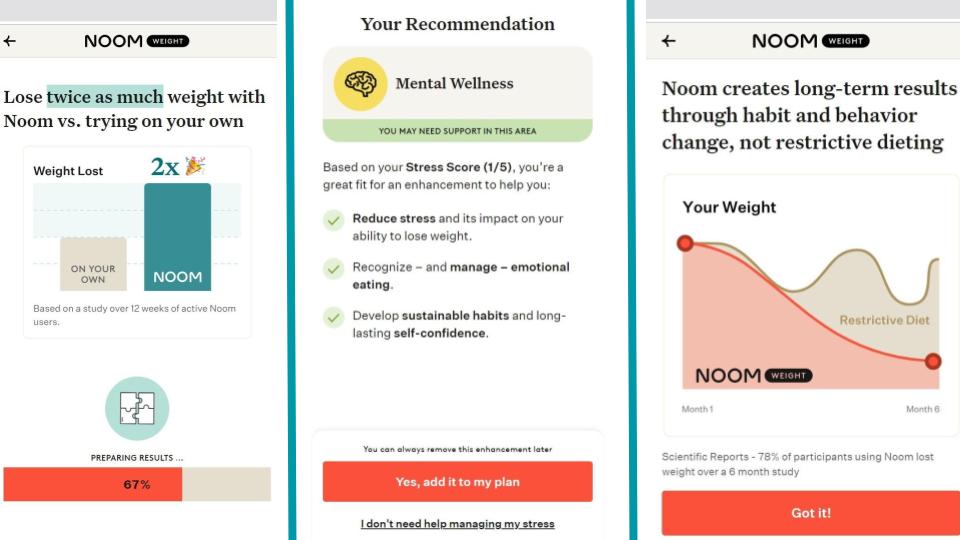
For food tracking, Noom uses a color-coded system that groups foods according to caloric and nutrient density. There are orange foods, yellow foods, and green foods. The more calorie-dense foods are categorized as orange foods (previously, they were classified as red foods, but the change likely came from the negative connotation associated with the color red).
Green foods are low-calorie and nutrient-dense—most green foods are whole grains, veggies, fruits, dairy, and unsweetened beverages like coffee. Yellow foods are somewhere in the middle.
In addition to food tracking and healthy eating, Noom also emphasizes physical activity and water tracking.
Noom is an app-only program, so you can only access your account through a phone or tablet. It’s available both on Apple and Android devices.
Who Should Try Noom
- Those who like the idea of a psychology-based program
- People who want to learn as they go
- Anyone who thrives with more targeted one-on-one coaching
- Those who don’t mind tracking their food.
For more information on the program and insight into our own personal experience, read our full Noom review.
What Is Weight Watchers?
WeightWatchers
WeightWatchers
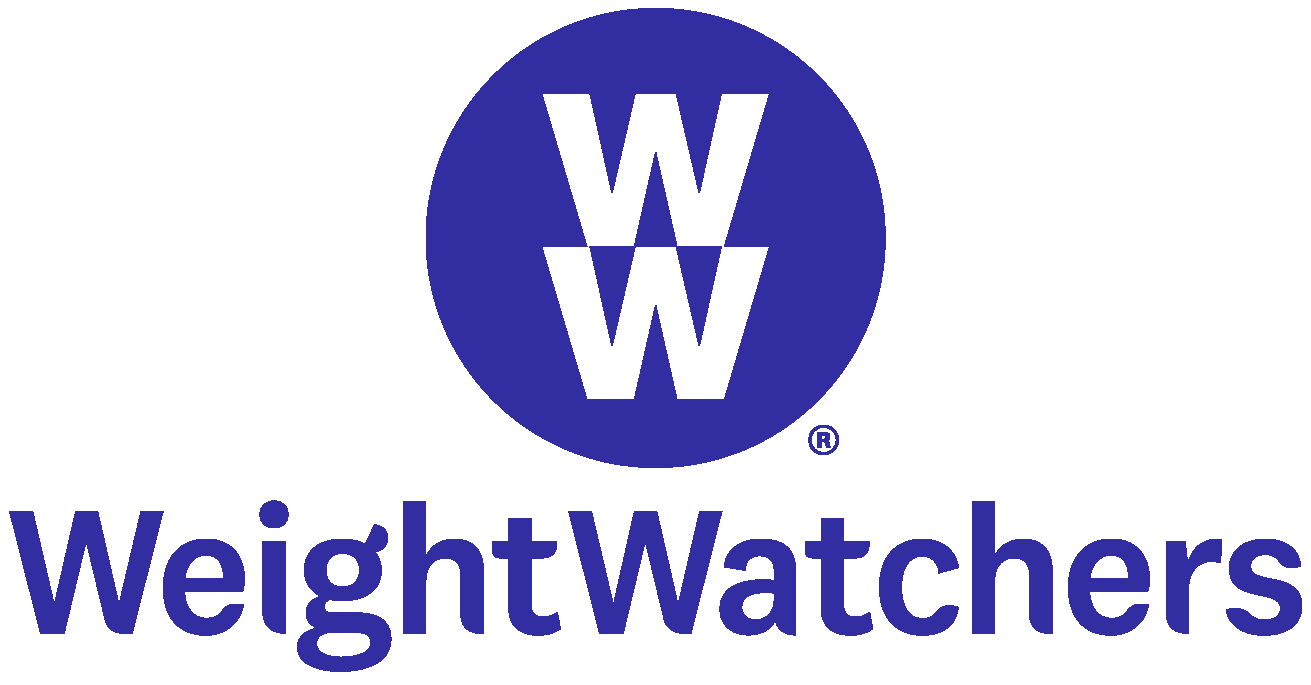
Product Highlights
- Designed specifically for weight loss
- Targeted quizzes to find the right plan for you
- Two membership options, starting at $23 per month
- Online-only or hybrid memberships available
- Works on a point budget system—no “off-limit” foods
- 24/7 support chat
Pros & Cons
Pros
- Point system allows you to tailor the plans to your preferences
- Online or hybrid options provide more flexibility
- Can choose a plan that works within your budget
- Includes an app for easier tracking
Cons
- Assigning Points to food is hard to translate to real-world eating when off the plan
- Tracking can be tedious
- Requires weekly weigh-ins, which can be problematic for some
Bottom Line
WeightWatchers is a flexible weight loss program that allows you to tailor your diet and lifestyle to your needs and preferences. There are two membership options: one for those who prefer in-person support, and one for those who are looking for an online program.
Founded in 1963, Weight Watchers is one of the longest-running weight loss programs. While the program has adapted to the times, the general approach has remained the same.
Weight Watchers uses a patented point system to help you reach your weight loss goals. The program is also designed to help with weight management.
You don’t count calories per se—instead, foods are given a point value based on their nutrient and calorie density. After inputting your current stats and your goals, you’re given a daily points budget. Calorie-dense foods have more points, while no-calorie foods are tagged as “ZeroPoint Foods.” You track everything you’re eating, with the goal of staying at (or under) your points budget.
There are some other nuances to consider, but the goal of Weight Watchers is to help you make healthier choices without any real food restrictions. There are no restrictions on macros like carbs or fat. Instead, these are higher-point foods, so you’ll naturally eat fewer of them when planning out your daily points.
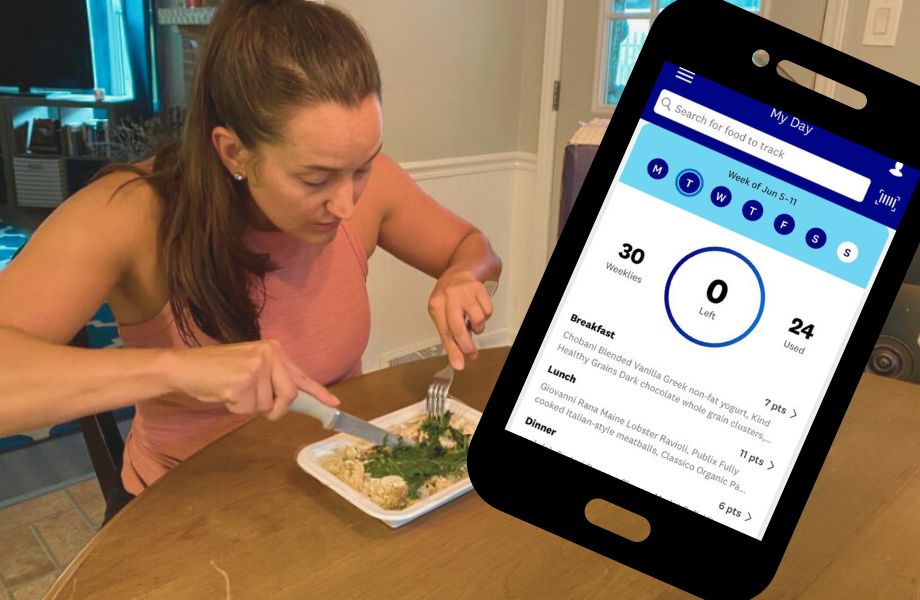
Weight Watchers also gives you access to a massive recipe database to easily track homemade foods, plus a barcode scanner for tracking packaged foods.
While food is the biggest focus of the program, you’ll also get a workout tracker and a huge community support group. Weight Watchers is actually known for its robust in-app and social communities. If connecting with peers is a priority for you, Weight Watchers has an edge here. You also have access to virtual coaches, but they aren’t as central to the program as with Noom.
Who Should Try Weight Watchers
- Those who thrive with more peer and community support
- People who don’t want as much one-on-one coaching
- Anyone who wants an in-person option
- Those who want to prioritize food tracking over other weight loss methods
For more information on this popular weight loss program, check out our in-depth Weight Watchers review.
Key Similarities Between Noom and Weight Watchers
Now that you have the background information on each weight loss plan, let’s look at the similarities:
No Calorie Counting
Both Noom and Weight Watchers rely on calorie restriction as a general principle, but neither program requires you to count calories directly. Instead, they each have a custom food tracking system—Weight Watchers uses a daily point allotment, while Noom uses a color-coded system.
That said, because foods are given arbitrary points values or colors, it can be difficult to transition off each program and continue with the food tracking because you don’t learn how to track macros or calories directly.
No Off-Limit Foods
Neither program has off-limit foods. You can work your favorite foods into your diet as long as you’re staying within your overall goals. Both programs operate with the philosophy that sustainable lifestyle changes allow for some leeway—you should enjoy a treat once in a while, and there’s room for it in your life as long as most of your food choices are healthy.
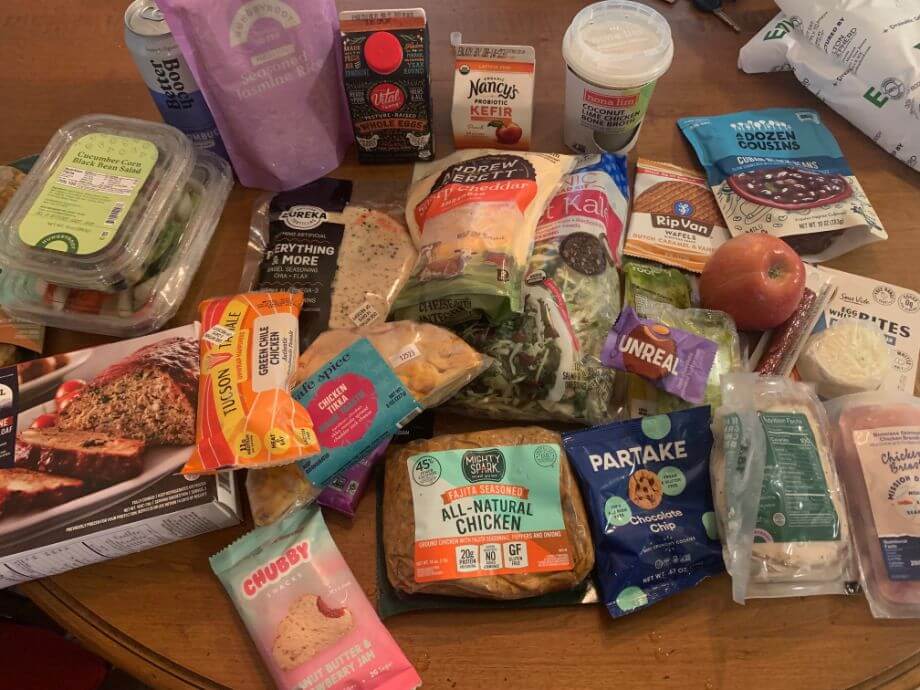
No Meal Plans
While both programs give you food guidance and categorized food lists—either in the form of points or colors—there are no structured meal plans. The goal is to learn healthy habits without strict guidance.
RELATED: Best Healthy Meal Delivery Service
Support
Both Noom and Weight Watchers offer support in the form of health coaches. You get access to personal coaching with your membership, and you can reach out to them for help staying on track with your diet plan. These are not registered dietitians or certified nutritionists, though. Neither program has strict guidelines for credentials.
There are also online communities and support groups within the apps, so you can connect with your peers to help you stay motivated on your weight loss journey.
That said, Noom emphasizes one-on-one coaching more than Weight Watchers. On the flip side, Weight Watchers has more available in the form of peer support.
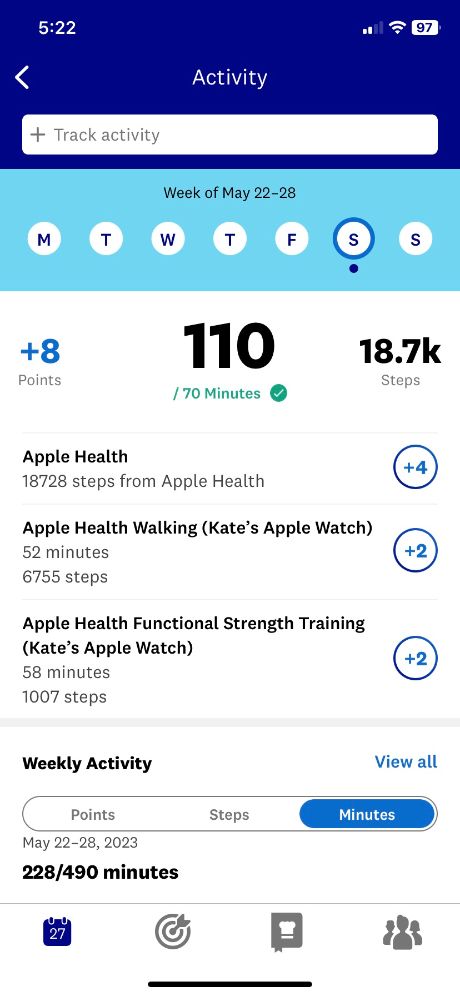
Medication Option
Both Noom and Weight Watchers have an option to add a GLP-1 medication to your program. These medications may help improve blood sugar and speed up weight loss1 by regulating appetite.
To qualify for this program, you’ll need a prescription from a doctor. Noom will connect you directly to a clinician, but you’ll have to go through your own with the Weight Watchers program.
Editor’s note: Weight Watchers utilizes telehealth services as part of their platform that may have affiliations with GLP-1 agonists; we aren’t evaluating or condoning that part of their program, just focusing on the whole-food approach the brand takes to weight loss.
Important Differences Between Noom and Weight Watchers
Of course, there are a few key differences, too:
Philosophy
Noom’s whole philosophy is that overeating and weight gain is usually a result of learned behaviors or underlying traumas. Because of this, a large part of the program focuses on correcting these behaviors through cognitive behavioral techniques and nutrition education.
Weight Watchers doesn’t take the same approach. This program is more focused on food tracking and paying attention to the types of food you eat. There’s not a huge focus on—or access to—nutrition education.
Structure
While both weight loss programs rely on food tracking, Weight Watchers is more structured than Noom. You’ll get a total number of daily points, and then you can build your diet around that point allotment.
Noom gives you a calorie budget but doesn’t tell you how many calories are in the foods you’re eating. Instead, you just use colors to track the foods. This can make it more difficult to stay within your calorie goals.
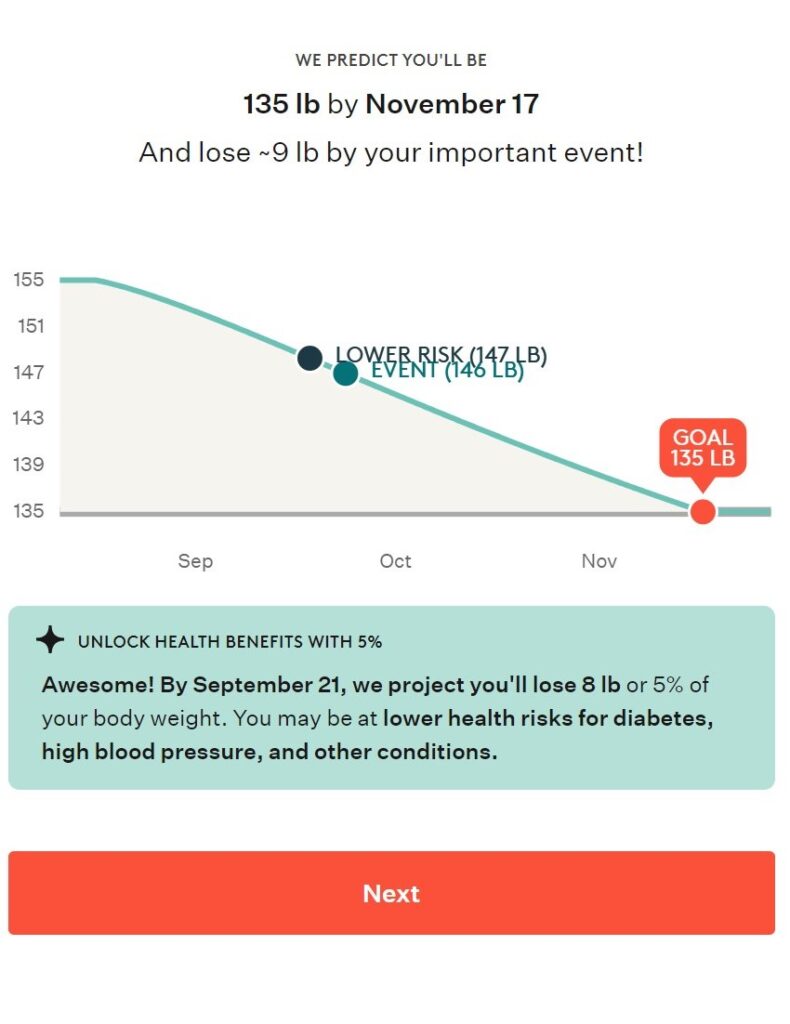
RELATED: What Is a Calorie Deficit?
Price
Noom is considerably more expensive than Weight Watchers, especially if you want a shorter-term plan. If you choose the month-to-month option, you’ll pay $70 per month for Noom. The first month of Weight Watchers will be $43, then $23 per month after that.
If you want to commit to a long-term subscription, the gap closes quite a bit. For a yearly plan, you’ll pay $17 per month for Noom (paid annually) and $10 per month for Weight Watchers.
Platforms
Noom is strictly app-based, while Weight Watchers gives you options. There’s a WW app, or you can access your account through the website. If you live near a Weight Watchers clinic, you can also visit in person for check-ins and weigh-ins and attend live workshops and seminars (for an extra fee).
Subscription Options
Both weight loss programs operate on a subscription basis, but the commitment options vary.
Weight Watchers is currently offering three choices: a monthly subscription, a three-month subscription, and 10-month subscription. Noom lets you choose monthly to yearly subscriptions—and everything in between. You can do a two-month, three-month, four-month, five-month…all the way to an 11-month auto-renewing plan.
As mentioned, the price is heavily dependent on which plan you choose. For Noom, the price varies widely. If you choose the monthly plan, you’ll pay $70 per month. If you commit to a full year, it breaks down to $17 per month, but you have to pay for the full year upfront.
Noom Vs Weight Watchers: Final Thoughts
Noom and Weight Watchers follow similar food-tracking approaches, but the Noom program focuses more on the psychology of eating habits and encouraging behavioral changes.
If you like the idea of daily lessons and health education, Noom may be the better choice for you. If you’d prefer to just track your food without a lot of extra information, Weight Watchers is likely the better fit. Those who want an in-person option should also opt for Weight Watchers since Noom is only accessible through the weight loss app.
Noom Vs Weight Watchers: FAQs
Should I join Noom or Weight Watchers?
It depends on what you’re looking for. If you want a psychology-based approach and value health education, Noom is probably the better option for you. If you respond well to community support and an easy way to track food, Weight Watchers will likely be the better fit. Those looking for more targeted one-on-one coaching will probably resonate better with Noom.
Does everyone get 1200 calories on Noom?
No, the calorie goal depends on your gender, current weight, and wellness goals. Women typically get around 1,200 to 1,320 calories per day, while men get 1,400 to 1,540 calories per day. The app interface won’t let you adjust your calorie goals lower than this to prevent undereating.
Why am I struggling to lose weight on Weight Watchers?
There could be several reasons. It may be possible you’re not tracking food correctly—you need to log everything, including snacks or small bites here and there. You may also have overestimated your activity level or current weight, so the suggested points budget is too high.
There’s also a chance that your expectations are too high. Sustainable weight loss takes time, and Weight Watchers isn’t a quick fix. You can expect to lose about one to two pounds per week on the program. At one pound per week, it may feel like you’re struggling to lose weight, but this is actually a sustainable and successful weight loss rate.
What is the most effective weight loss program out there?
At the risk of sounding cliche, the most effective weight loss program is one that you can stick to. To be successful in a program, you have to resonate with the overall approach and philosophies. Otherwise, you’ll likely fall off pretty quickly.
That said, in a 2016 review published in the Annals of Internal Medicine2, researchers found that after 12 months, participants following the WeightWatchers program lost 2.6% more weight than people who got other standard weight loss education.
Another report published in Scientific Reports3 in 2016 looked at the Noom Program and found that almost 78% of participants successfully lost weight.
TL;DR: Either Noom and Weight Watchers can be effective if you follow them closely and stay consistent.
These statements have not been evaluated by the Food and Drug Administration. This product is not intended to diagnose, treat, cure, or prevent any diseases.
References
- White GE, Shu I, Rometo D, Arnold J, Korytkowski M, Luo J. Real-world weight-loss effectiveness of glucagon-like peptide-1 agonists among patients with type 2 diabetes: A retrospective cohort study. Obesity (Silver Spring). 2023 Feb;31(2):537-544. doi: 10.1002/oby.23622. Epub 2023 Jan 9. PMID: 36621904; PMCID: PMC9877131.
- Gudzune KA, Doshi RS, Mehta AK, Chaudhry ZW, Jacobs DK, Vakil RM, Lee CJ, Bleich SN, Clark JM. Efficacy of commercial weight-loss programs: an updated systematic review. Ann Intern Med. 2015 Apr 7;162(7):501-12. doi: 10.7326/M14-2238. Erratum in: Ann Intern Med. 2015 May 19;162(10):739-40. doi: 10.7326/L15-5097. PMID: 25844997; PMCID: PMC4446719.
- Chin SO, Keum C, Woo J, Park J, Choi HJ, Woo JT, Rhee SY. Successful weight reduction and maintenance by using a smartphone application in those with overweight and obesity. Sci Rep. 2016 Nov 7;6:34563. doi: 10.1038/srep34563. PMID: 27819345; PMCID: PMC5098151.



